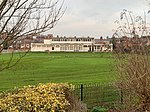Leicester power station
Buildings and structures in LeicesterCoal-fired power stations in EnglandDemolished power stations in the United KingdomFormer power stations in England

Leicester power stations are a series of electricity generating stations that have provided electric power to the City of Leicester and the wider area from 1894. The first station, located within Aylestone gas works, supplied electricity for street lighting. The city’s new electric tram system was supplied from 1904 by a station at Lero which operated until 1930. A large coal-fired power station was constructed at Freemans Meadow in 1922 and was operational until 1976. Finally a gas turbine power plant was commissioned in 1976.
Excerpt from the Wikipedia article Leicester power station (License: CC BY-SA 3.0, Authors, Images).Leicester power station
Filbert Way, Leicester Bede Island
Geographical coordinates (GPS) Address Website Nearby Places Show on map
Geographical coordinates (GPS)
| Latitude | Longitude |
|---|---|
| N 52.619722222222 ° | E -1.1433333333333 ° |
Address
King Power Stadium
Filbert Way
LE2 7FL Leicester, Bede Island
England, United Kingdom
Open on Google Maps







